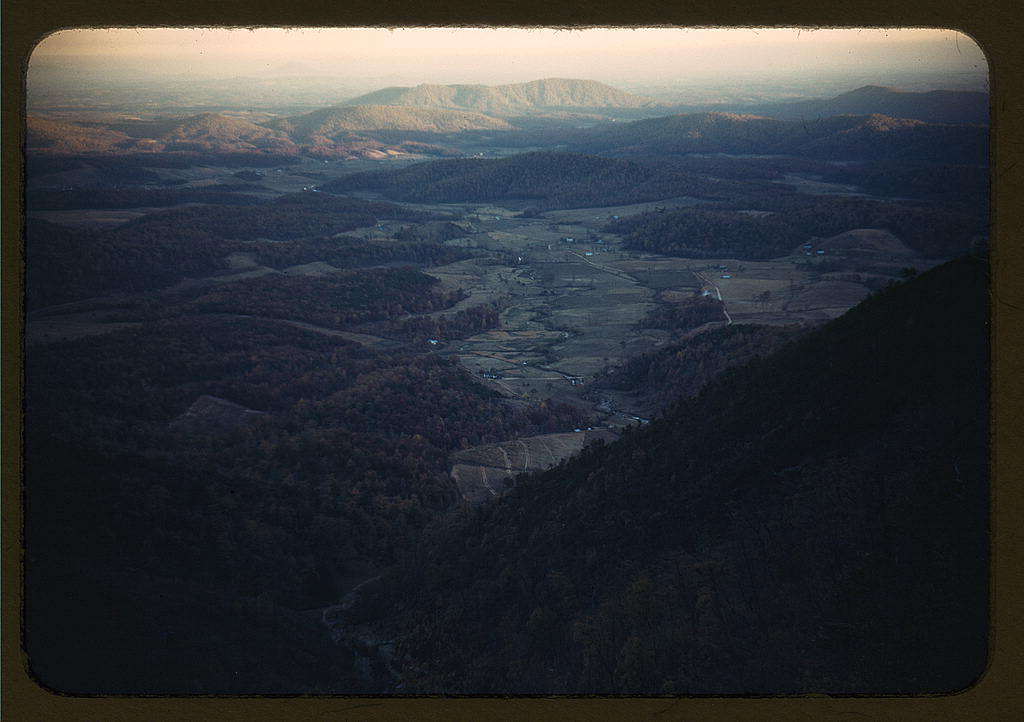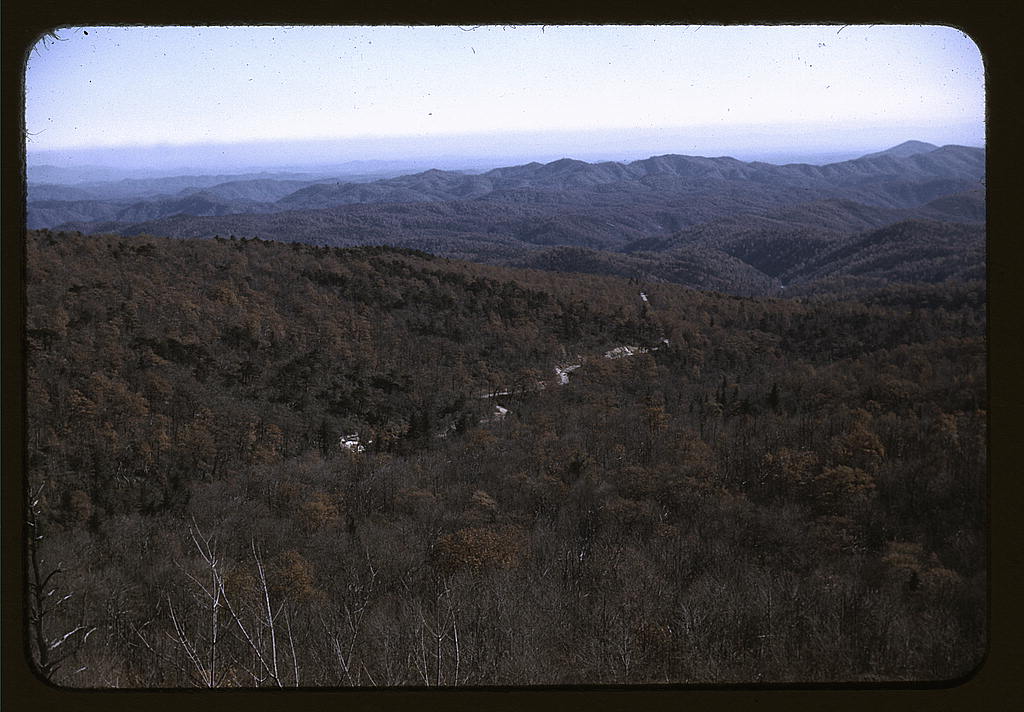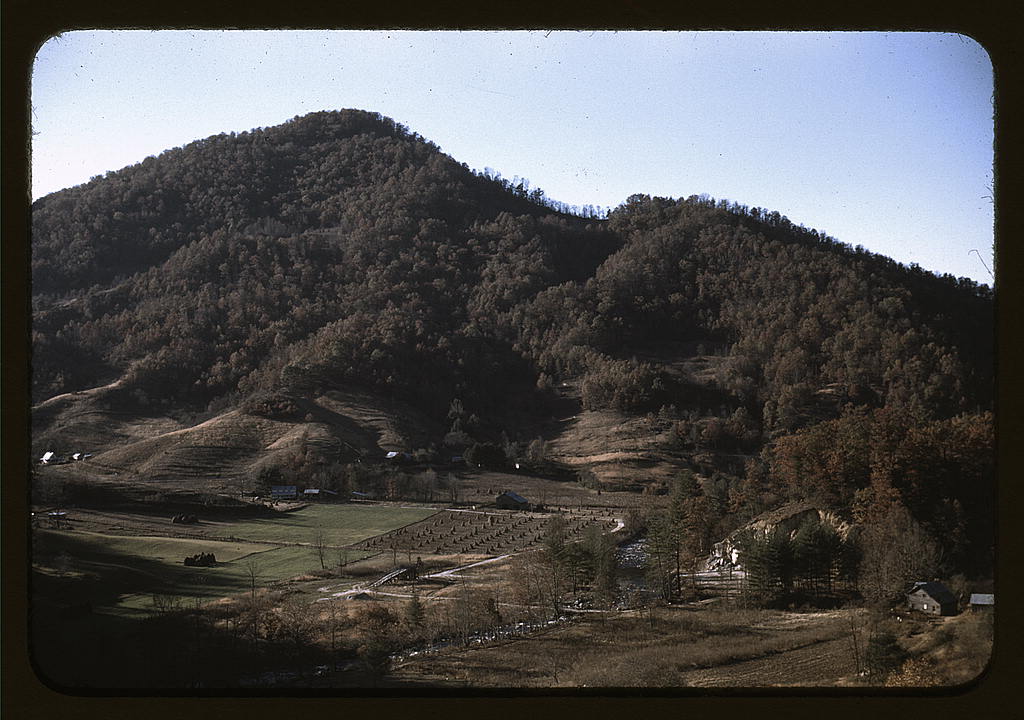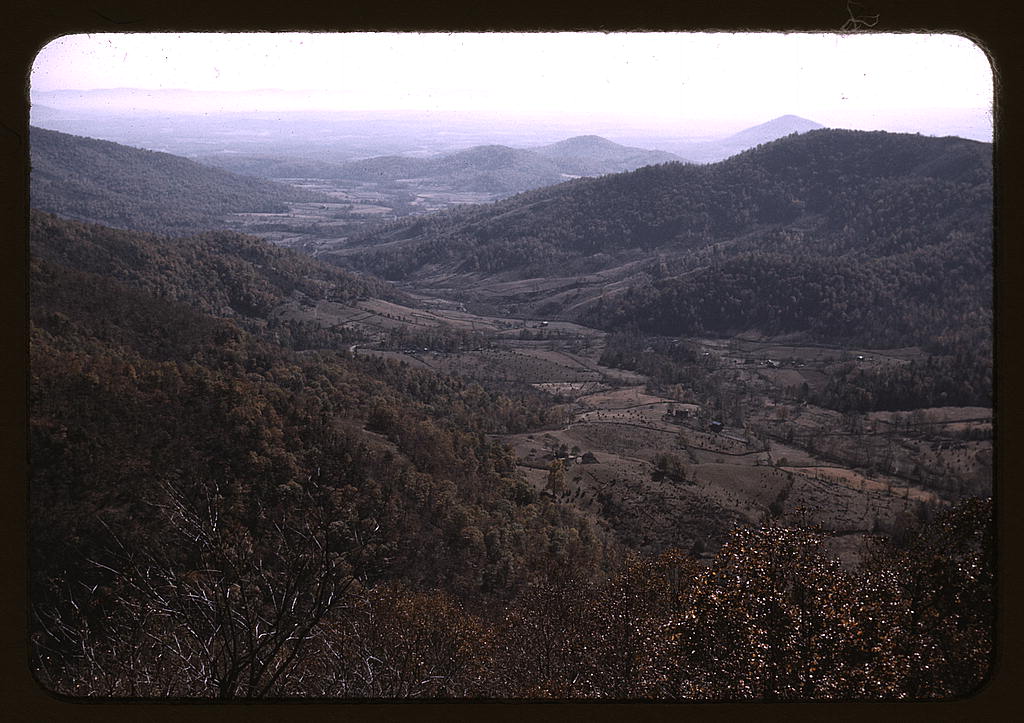.

Mountain farms along Skyline Drive, Virginia: photo by Jack Delano, c. 1940

View in the mountains along Skyline Drive, Blue Ridge Mountains, Virginia: photo by Jack Delano, c. 1940

Road to Corbin Hollow from Skyline Drive. Shenandoah National Park, Virginia: photo by Arthur Rothstein, October 1935

Road to Corbin Hollow. Shenandoah National Park, Virginia: photo by Arthur Rothstein, October 1935

Fennel Corbin. Shenandoah National Park, Virginia: photo by Arthur Rothstein, October 1935

Fennel Corbin. Shenandoah National Park, Virginia: photo by Arthur Rothstein, October 1935

Sam Corbin. Shenandoah National Park, Virginia: photo by Arthur Rothstein, October 1935

Son of Fannie Corbin. Shenandoah National Park, Virginia: photo by Arthur Rothstein, October 1935

Son of Fannie Corbin. Shenandoah National Park, Virginia: photo by Arthur Rothstein, October 1935

Son of Fannie Corbin, fifteen years old. Shenandoah National Park, Virginia: photo by Arthur Rothstein, October 1935

One of the Corbin children, Shenandoah National Park, Virginia: photo by Arthur Rothstein, October 1935

Mountaineer's home, Corbin Hollow, Shenandoah National Park, Virginia: photo by Arthur Rothstein, October 1935

Mountaineer's home in Corbin Hollow. Shenandoah National Park, Virginia: photo by Arthur Rothstein, October 1935

Inhabitant of Corbin Hollow, Virginia: photo by Arthur Rothstein, October 1935

Child in Corbin Hollow, Virginia: photo by Arthur Rothstein, October 1935

Broken Back Run, a path to Dicee Corbin's cabin. Shenandoah National Park, Virginia: photo by Arthur Rothstein, October 1935

Dicee Corbin's cabin. Shenandoah National Park, Virginia: photo by Arthur Rothstein, October 1935

Detail of cabin construction, Virginia: photo by Arthur Rothstein, October 1935

One of Dicee Corbin's children, Shenandoah National Park, Virginia: photo by Arthur Rothstein, October 1935

One of Dicee Corbin's children, Shenandoah National Park, Virginia: photo by Arthur Rothstein, October 1935

Dicee Corbin and daughter, Shenandoah National Park, Virginia: photo by Arthur Rothstein, October 1935

Barn in Corbin Hollow, Virginia: photo by Arthur Rothstein, October 1935

Cabin at Corbin Hollow, Shenandoah National Park, Virginia: photo by Arthur Rothstein, October 1935

Half-wit Corbin Hollow boy, Shenandoah National Park, Virginia: photo by Arthur Rothstein, October 1935

Old Ragged Mountain. Old Rag, Shenandoah National Park, Virginia: photo by Arthur Rothstein, October 1935

Barn on road to Old Rag. Shenandoah National Park, Virginia: photo by Arthur Rothstein, October 1935

Barn and outhouses at Old Rag. Shenandoah National Park, Virginia: photo by Arthur Rothstein, October 1935

Kitchen utensils in a Blue Ridge Mountain home, Virginia: photo by Arthur Rothstein, October 1935

Mrs. Dodson and one of her nine children, Old Rag. Shenandoah National Park, Virginia: photo by Arthur Rothstein, October 1935

Mrs. Dodson and some of her children. Old Rag, Shenandoah National Park, Virginia: photo by Arthur Rothstein, October 1935

Postmaster Brown at Old Rag. Shenandoah National Park, Virginia: photo by Arthur Rothstein, October 1935

Wife of Postmaster Brown. Old Rag, Shenandoah National Park, Virginia: photo by Arthur Rothstein, October 1935

Two of Mrs. Brown's grandchildren. Old Rag, Shenandoah National Park, Virginia: photo by Arthur Rothstein, October 1935

House at Old Rag. Shenandoah National Park, Virginia: photo by Arthur Rothstein, October 1935

Barnyard at Old Rag. Shenandoah National Park, Virginia: photo by Arthur Rothstein, October 1935

Farm on the banks of the Hughes River at Nethers. Shenandoah National Park, Virginia: photo by Arthur Rothstein, October 1935

A house in the village of Nethers. Shenandoah National Park, Virginia: photo by Arthur Rothstein, October 1935

Main street at Nethers, Virginia: photo by Arthur Rothstein, October 1935

Post office at Nethers. Shenandoah National Park, Virginia: photo by Arthur Rothstein, October 1935

Citizens of Nethers in front of post office, Virginia: photo by Arthur Rothstein, October 1935

Miller at Nethers, Virginia: photo by Arthur Rothstein, October 1935

Mill at Nethers, Virginia: photo by Arthur Rothstein, October 1935

Interior of mill at Nethers, Virginia: photo by Arthur Rothstein, October 1935

Waterwheel of mill, Nethers, Virginia: photo by Arthur Rothstein, October 1935

Fields near Sperrryville, Virginia: photo by Arthur Rothstein, October 1935

Rail fence, Blue Ridge Mountains, Virginia: photo by Arthur Rothstein, November 1937

Hilly farmland. Blue Ridge Mountains, Virginia: photo by John Vachon, October 1937

Hezekiah Lam and daughter. Hollow folk who beg along Skyline Drive, Blue Ridge Mountains, Virginia: photo by John Vachon, November 1937

Hezekiah Lam, eighty-three-year-old father with his daughter. Hollow folk who beg along Skyline Drive, Blue Ridge Mountains, Virginia: photo by John Vachon, November 1937

Corbin Hollow ruins, Blue Ridge Mountains, Virginia: photo by John Vachon, November 1937

Trees in Shenandoah National Park, Blue Ridge Mountains, Virginia: photo by John Vachon, October 1937

Farm in the Blue Ridge Mountains, Virginia: photo by John Vachon, October 1937

Mountain farm along the Skyline Drive, Blue Ridge Mountains, Virginia: photo by Jack Delano, c. 1940




24 comments:
Tom,
Such a journey back in time -- carry me back to old Virginie, Blue Ridge Mountains where I long to be, all those songs that echoed across those hills, all that is missing now (all those people), although Jack Delano gets it here, even some 70-plus years ago. . .
5.6
first edge of sun rising above shadowed
plane of ridge, moon across from branch
in foreground, sound of wave in channel
light seen in fact, setting
likeness the color of
the center of that which is,
against, toward which
silver of sunlight reflected in channel,
line of pelicans gliding toward horizon
Thanks Tom,Yes, some of the great names here , , , and 'light seen in fact' as Stephen puts it, names well what Delano and Vachon and Rothstein pictured for us. A mountain way of life. Much obliged.
A wonderful series of images. Thanks Tom.
These pictures were taken shortly after the park was founded. A bit about this from Mother Wikipedia:
"Shenandoah was authorized in 1926 and fully established on December 26, 1935. Prior to being a park, much of the area was farmland and there are still remnants of old farms in several places. The Commonwealth of Virginia slowly acquired the land through eminent domain and then gave it to the U.S. Federal Government provided it would be designated a National Park.
In the creation of the park [the Skyline Drive right-of-way was purchased from owners without condemnation], a number of families and entire communities were required to vacate portions of the Blue Ridge Mountains. Many residents in the 500 homes in eight affected counties of Virginia were vehemently opposed to losing their homes and communities. Most of the families removed came from Madison County, Page County, and Rappahannock County.
Nearly 90% of the inhabitants worked the land for a living. Many worked in the apple orchards in the valley and in areas near the eastern slopes. The work to create the National Park and Skyline Drive began following a terrible drought in 1930 which destroyed the crops of many families in the area who farmed in the mountainous terrain, as well as many of the apple orchards where they worked picking crops. Nevertheless, it remains a fact that they were displaced, often against their will, and even for a very few who managed to stay, their communities were lost. A little-known fact is that, while some families were removed by force, a few others (who mostly had also become difficult to deal with) were allowed to stay after their properties were acquired, living in the park until nature took its course and they gradually died. The policy allowed the elderly and disabled who so wished to remain with life tenancy. The last to die was Annie Lee Bradley Shenk who died in 1979 at age 92. Most of the people displaced left their homes quietly. According to the Virginia Historical Society, eighty-five-year-old Hezekiah Lam explained, 'I ain't so crazy about leavin' these hills but I never believed in bein' ag'in the Government. I signed everythin' they asked me.' The lost communities and homes were a price paid for one of the country's most beautiful National Parks and scenic roadways."
This is all very close to my childhood "neck of the woods." This area is so close to my heart, despite my so rarely returning. The postmaster's wife had a vague resemblance to my Gran (my mother's mother), who because she was illiterate to the day she died would buy me birthday & Christmas cards, and have me read them to her. Her eastern Kentucky home, less rickety than those shown here, but with its share of gaps that had to be annually plugged, always smelled vaguely of old burnt bacon. My greatest regret is my childhood disdain for visiting.
This is where I grew up - pretty much home. I still see these people when I drive back--or so it seems. Esp if we go thru W. Va..
What a remarkable assembly. I first saw the Blue Ridge Mountains following a sad event in our family when my father decided it would be a good time to get away and I'll never forget what I saw there. These open whole new Rothstein and Vachon worlds to me. I suppose my favorite shot is the Rothstein photo of the fields near Sperryville, VA, but it's hard to choose. Curtis
The evidences of a stubborn independence, of possibly a certain atavism, and above all of a sweeping absence of modern technological conveniences, interested me.
Some irony in the latter deficit, in that were it not for the camera, they would not be alive (as ghosts) for us now --- the hollow, old rag, nethers people.
Readers will have noted that the eighty-three-year-old Hezekiah Lam, begging along Skyline Drive with his daughter in two of the final Vachon shots toward the bottom of the post, is doubtless one-and-the-same with the eighty-five-year-old Hezekiah Lam mentioned in the wiki article on the Shenandoah Holdouts which Chris has quoted above.
John Vachon's shot of the ruins of Corbin Hollow, taken twenty-five months after Arthur Rothstein's October 1935 sojourn, does give pause.
Not coincidentally, it's a pleasure to have in the company some who know this part of the country well.
For them and for everybody, then, a night ride through the foothills of the Blue Ridge with Bert Brecht.
The nettle cabin, the postmaster, the broken windows stuffed with rags - you've put together a fascinating collection of a part of the US that I have never travelled through and have not until now given much thought to. Thank you.
Many thanks, Kevin.
The place as seen here is a part of the past. But we virtual travelers can get there this way.
I've been caught in a rut on the road to Corbin Hollow all week, with occasional side trips up Broken Back Run.
tc this post is home. and i went to 4th and 5th grades with quite a few corbins. frederick county.
:)
Now how did I know that??
The memory of your poems (and your photos too) definitely played about the mind, in the making of this. Thanks again for keeping it all real, and green, that freshly remembered past. The memorial function must be the oldest, possibly also best use of poetry.
since i've moved to boyce (also my grandfather's middle name) i find myself feeling more ghost than real. the landscapes are for the most part unchanged since beginning, some mornings i feel much closer to past lives than the one i'm living. the skyline is constant.
This must be the place?
wow, that's so weird. the sign says boyce, but that looks just like the entrance to the berryville grille in bville..this is the shot i found, too bad it isn't facing direct.
http://www.flickr.com/photos/11364558@N00/5101578780/
Hmm. Well, the Clarke County Fair advertisement. Right county anyway.
There's also one Joe Bott (aka DeadFred) who's all over Boyce history & genealogy, c. 1931, e.g.:
James Connor's House on Walnut Hill Farm, Boyce Va. July 1931.
Oldest shot from Boyce I've been able to find is this one -- a half mile south of town, home of the dude who beat off the British. Back in the deep day.
General Daniel Morgan House, 1791.
it's so hard to tell. i've decided to take pictures. it doesn't look like anything has changed here since the beginning of time, but i suppose i'm way off base. i'll need some time to get around and snapshot..
Hey, this may be totally spurious, but I'm curious how Nethers got its name. One of my most distant pre-colonial relatives, George Nethers/Nathers was an escaped indentured servant who settled... basically... there. So I'm curious if there's a connection, or if you know anything about the early history?
I lived in Freestate back in the 70's after the Rainbow Tribe moved out. Does anyone know about Freestate aka Hippie Haven? I remember names of locals like Silas and Oscar Sisk and Billy Boot Jenkins. Any of those names ring a bell? It was tough living off the land at Freestate with the old boys running their still up the way and poaching deer up through the parkline. What a strange clash of cultures. Does anyone have any info on Freestate and who ran it. Was it someone with the last name of Perry or someone named Richard? I can't remember. I only lived there as an innocent back to the land teenager from the city. Didn't last long as the locals didn't take too kindly to outsiders. Thanks, bjmatson@gmail.com
Hey, I lived at Freestate in 76 for awhile. In the old geodesic dome. Does anyone remember the shelters there? Who owned it? Richard Perry or something like that... Things didn't go so well after awhile due to the locals not taking kindly to having "hippies" too close to their still. I do remember some of their names. Billy Boot Jenkins, Oscar Sisk. Real backwoods people. Does anyone have any more info on Freestate? Thanks so much, BJ Matson
It was called Ragged Mountain Ranch when I was there in 1971. It was owned by Marion Pettie. Richard and I got married there in a double wedding and several locals came to the wedding including Oscar Sisk's kids. We lived in Oscars cabin, ( the one he was borne in, up the rutted hill from his house ) with Fred and Jean Lewis during the time Richard built the yurt with the geodesic dome in the old burnt out peach orchard. A few years later someone built an add-on part to it. The ranch lived many interesting lives thru the 60's and 70's. Marion Pettie was quite a character. 1971 was a very good year at Nethers. I loved Etlan General Store. No one would ever talk to us there but they had good ice cream and Marlboro Cigarettes.
I enjoyed seeing the photos. What is their source? Do you know where I can purchase a copy of the 18 Cabins of Old Rag - a Field Guide for Bushwhackers?
The photos all come from the source which is identified at the bottom of the post.
I mean, Jeez.
Post a Comment